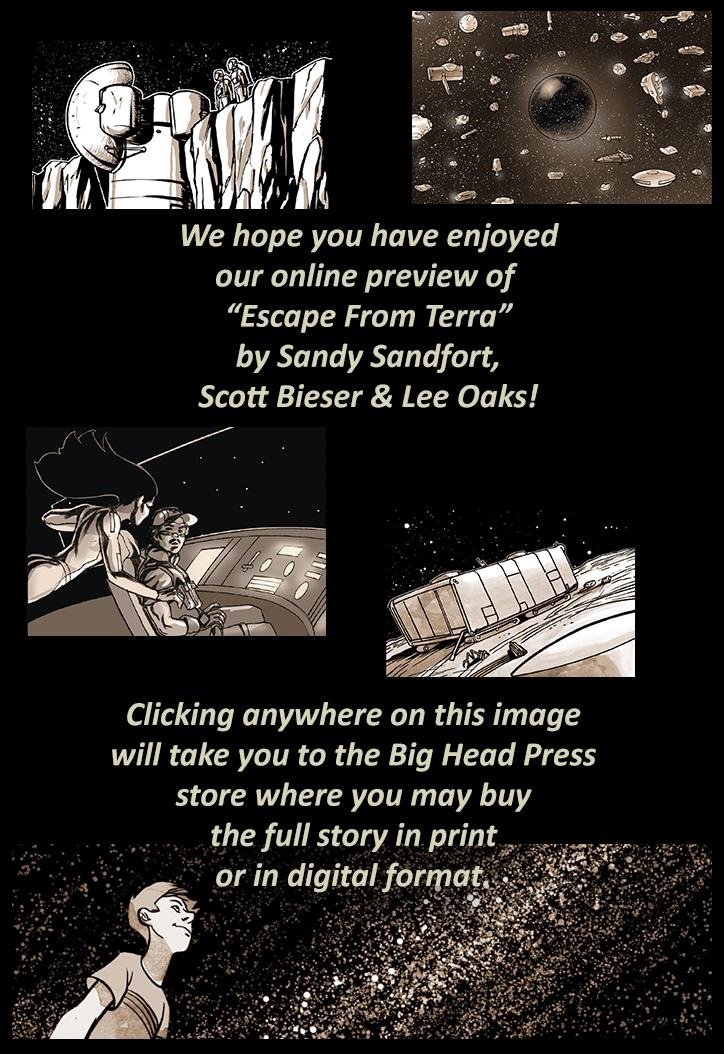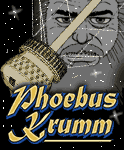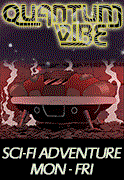|
Strip 732 -- First Seen: 2011-06-24
Escape From Terra is updated with new pages every Monday through Friday.
Kickstarter Success!
The Not-Safe-Space 2 Kickstarter Campaign has ended successfully. Thanks to all who pledged!
Now we get to wait 2 weeks while Kickstarter transmits the funds, and Scott can order the books, and send surveys to backers to get current e-mail addresses for the .PDF versions and mailing addresses for the physical books.
All of this should show up in June.
The Transcript For This Page
Panel 1
Very large panel, about 1/2 of the page. Centered is Black Sky Station II, a floating transfer-station between interplanetary and local modes. Its design reflects that of the V-ships – five thick tube-shapes spread starfish-like from a central vertex. Like the V-ships, each tube is flattened in cross-section, 400 meters wide to 200 meters tall. Each tube is 5 km long. Underneath each is a small framework of walkways, cart-ways, and conduits connecting docking portals for the various ships transferring passengers and cargo, some of which are other V-ships like Variable Star, and some others are local runners, also v-shaped airships but only a fifth the size of the interplanetary craft, and with v-legs at a sharper, 30-degree angle. The Variable Star enters the frame from a high angle on the left. One of the smaller dirigibles is departing to the lower right. We see Venus below, black sky above.
See http://jpaerospace.com/atohandout.pdf for reference.
Caption: Black Sky Station II was an aerostat floating 100 kilometers above Venus' blast-furnace surface. At that altitude, the sky was indeed black.
Caption: It was a transfer station between the V-ships, which could not enter the lower atmosphere, and the sturdier air buses which could survive down to the 60-kilometer level, where the air-pressure is equal to that of ground-level Terra.
Panel 2
Tall panel, 1/3 page wide. Sort of a diagram of a slice of Venus' atmosphere, from space down to the surface. The upper fifth of the area is black – where very thin thins out to vacuum at the top. The bottom half-inch of the panel is the surface – a jumble of volcanic rock. The air in the next inch above the surface is very hot and super-dense – use wavy lines pointed upward to indicate the extreme environment. Above that, up to about halfway to the top, are dense, swirling clouds. At half-way point the clouds thin out a bit, so that by about an inch above the half-way mark, there is almost as much open-air as cloud. The clouds continue thinning going upward, and are gone by the ¾ mark and the sky darkens gradually up to the black area. Just where the grey turns black, we see the Dark Sky Station I, which looks a bit like Black Sky Station II, but not exactly. Leave a black strip about 3/16' wide along the left side where I will slug in an altitude scale.
Just above the 1/3 high mark, have a tiny silhouette-figure of a man, falling, and blazing as he goes down.
Caption: The temperature at the Venusian surface is 460°C – hotter than Mercury -- and the pressure is 92 times as dense as Terra's.
Caption: During the construction of Dark Sky Station I, a worker fell many kilometers to a most grisly death from heat and pressure.
Panel 3
Middle row, right 2/3 page wide. Kind of a futuristic version of a scene from one of the 'CIS' shows, where someone in worker's gear is seated at a table being interviewed by someone in a suit, and we see all this through a glass with two more detective-types looking on from our side of the glass.
Caption: Though the accident was suspicious, an investigation failed to find any hard evidence of sabotage.
Caption: But many blamed the Theodorians … 'Teddies' for short.
Panel 4
Bottom row, right 2/3 of page. A scene with a bunch of people at a meeting. We see a few dozen people from behind, seated auditorium-style, and three figures on an elevated platform seated behind a table. People are mostly in shadow, we don't really see any recognizable faces, and the scene should look sinister and foreboding.
Caption: The Teddies were extremely violent primitivists.
Caption: Paradoxically – or perhaps hypocritically – Teddies used the most advanced technology to carry out their deadly attacks against technology, its developers and users.
|
|





















